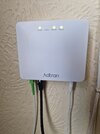Hi all,
I want to move the internal wall mounted phone socket so that i can move my router to a different place in the house.
There is already a cable running around the outside wall to where the socket is now but i need to replace it with a longer one for the new location.
What cable do i need?
Thanks
I want to move the internal wall mounted phone socket so that i can move my router to a different place in the house.
There is already a cable running around the outside wall to where the socket is now but i need to replace it with a longer one for the new location.
What cable do i need?
Thanks




